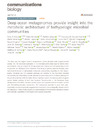Identificador persistente para citar o vincular este elemento:
https://accedacris.ulpgc.es/jspui/handle/10553/107460
| Título: | Deep ocean metagenomes provide insight into the metabolic architecture of bathypelagic microbial communities | Autores/as: | Acinas, Silvia G. Sánchez, Pablo Salazar, Guillem Cornejo-Castillo, Francisco M. Sebastián Caumel, Marta Logares, Ramiro Royo-Llonch, Marta Paoli, Lucas Sunagawa, Shinichi Hingamp, Pascal Ogata, Hiroyuki Lima-Mendez, Gipsi Roux, Simon González, José M. Arrieta, Jesús M. Alam, Intikhab S. Kamau, Allan Bowler, Chris Raes, Jeroen Pesant, Stéphane Bork, Peer Agustí, Susana Gojobori, Takashi Vaqué, Dolors Sullivan, Matthew B. Pedrós-Alió, Carlos Massana, Ramon Duarte, Carlos M. Gasol, Josep M. |
Clasificación UNESCO: | 2510 Oceanografía | Palabras clave: | Environmental microbiology Microbial biooceanography Microbial ecology |
Fecha de publicación: | 2021 | Proyectos: | Expedición de circunnavegación MALASPINA 2010: Cambio global y exploración del océano global | Publicación seriada: | Communications Biology | Resumen: | The deep sea, the largest ocean’s compartment, drives planetary-scale biogeochemical cycling. Yet, the functional exploration of its microbial communities lags far behind other environments. Here we analyze 58 metagenomes from tropical and subtropical deep oceans to generate the Malaspina Gene Database. Free-living or particle-attached lifestyles drive functional differences in bathypelagic prokaryotic communities, regardless of their biogeography. Ammonia and CO oxidation pathways are enriched in the free-living microbial communities and dissimilatory nitrate reduction to ammonium and H2 oxidation pathways in the particle-attached, while the Calvin Benson-Bassham cycle is the most prevalent inorganic carbon fixation pathway in both size fractions. Reconstruction of the Malaspina Deep Metagenome-Assembled Genomes reveals unique non-cyanobacterial diazotrophic bacteria and chemolithoautotrophic prokaryotes. The widespread potential to grow both autotrophically and heterotrophically suggests that mixotrophy is an ecologically relevant trait in the deep ocean. These results expand our understanding of the functional microbial structure and metabolic capabilities of the largest Earth aquatic ecosystem. | URI: | https://accedacris.ulpgc.es/handle/10553/107460 | ISSN: | 2399-3642 | DOI: | 10.1038/s42003-021-02112-2 | Fuente: | Communications Biology [EISSN 2399-3642], v. 4 (1), 604, (Diciembre 2021) |
| Colección: | Artículos |
Citas SCOPUSTM
119
actualizado el 08-jun-2025
Citas de WEB OF SCIENCETM
Citations
141
actualizado el 18-ene-2026
Visitas
61
actualizado el 10-ene-2026
Descargas
45
actualizado el 10-ene-2026
Google ScholarTM
Verifica
Altmetric
Comparte
Exporta metadatos
Los elementos en ULPGC accedaCRIS están protegidos por derechos de autor con todos los derechos reservados, a menos que se indique lo contrario.
